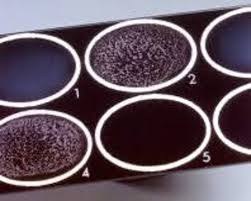Latex agglutination assays for mycology

A latex fixation test, also called a latex agglutination assay or test (LA assay or test), is an assay used clinically in the identification and typing of many important microorganisms
These tests use the patient's antigen-antibody immune response. This response occurs when the body detects a pathogen and forms an antibody specific to an identified antigen (a protein configuration) present on the surface of the pathogen.
Latex agglutination is observed when a sample containing the specific antigen (or antibody) is mixed with an antibody (or antigen) which is coated on the surface of latex particles.
The reaction between a particulate antigen and an antibody results in visible clumping called agglutination. Antibodies that produce such reactions are known as agglutinins. The principle of Agglutination reactions are similar to precipitation reactions; they depend on the cross linking of polyvalent antigens. When the antigen is an erythrocyte it is called hemagglutination.Theoretically all antibodies can agglutinate particulate antigens but IgM, due to its high specificity is a particularly good agglutinin.
There is no agglutination can be observed when the concentration of antibody is high, (lower dilutions), and then the sample is diluted, agglutination occurs. Prozone effect is defined as the invisibility of agglutination at high concentrations of antibodies. It is due to the reason that excess antibody forms very minute complexes that do not clump to form visible agglutination.
Cat number
Product name
Size

